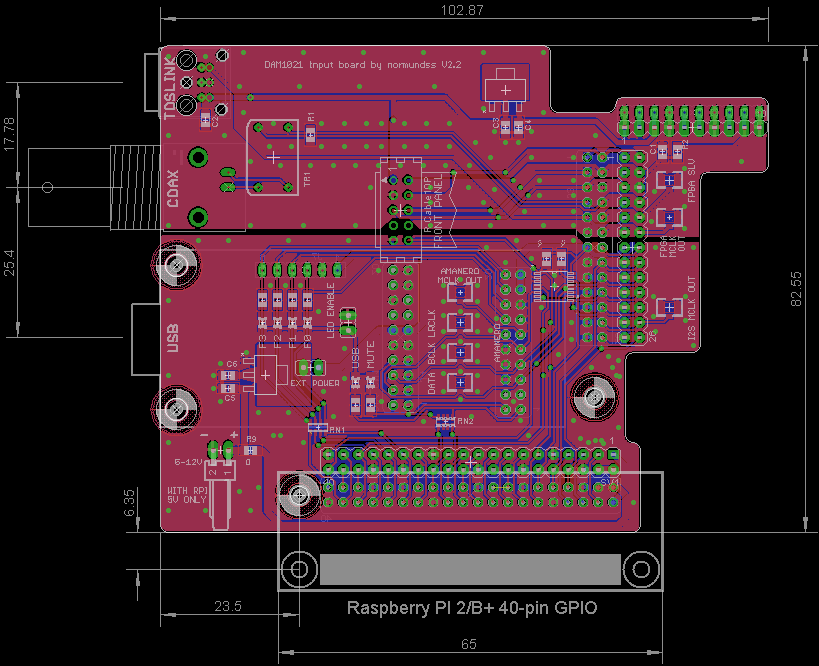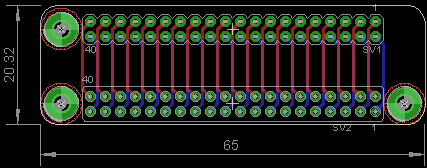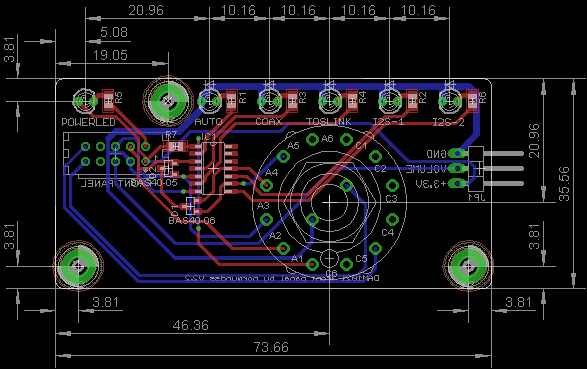At this point I can say that there will be an updated version of the input boards including an I2S input selector.
- There will be support for directly attaching Raspberry Pi 2 / B+ using a 40-pin connector.
- There may be support for directly attaching DIYINHK USB interface. This is not completely worked out yet.
- I2S input 1 can be connected to Amanero/DIYINHK USB/U.FL connectors and input 2 to RPi. Other I2S sources can also be connected to those inputs. Only one source can be physically connected to each input at the same time.
- The input selection will be controlled by a logic level control pin. It can be controlled by a mechanical switch, or from a microcontroller such as RPi/Arduino/etc. There will be an updated accompanying switch board to support switching of additional inputs.
- The Raspberry Pi connector is expected to include support for I2S lines, isolated serial connection, I2S input selection using a GPIO pin, and maybe also reading the Amanero/DIYINHK status.
- Support for other expected new features of DAM1021 will be evaluated when the new DAM firmware becomes available. Most notably that includes chaining of multiple DACs.
Input board V2 draft design
Here is a draft design for updated input boards. This is a good time to make suggestions and feature requests 🙂

The most important differences from V1 boards:
There will be a small PCB for connecting Raspberry PI as outlined at the bottom of the drawing. It will allow directly plugging in RPi without additional cabling. RPi would be oriented upside down, with USB/Ethernet connectors facing left. This way the RPi HDMI and power connectors are also easily accessible and HDMI can be routed to the front or back panel by using a pigtail cable. The Micro-SD card is accessible from the right side.
Everything is designed to fit in a 1U case (40 mm height).
The USB interface status connections use 6 (for Amanero) or 4 (for DIYINHK) GPIO pins on Raspberry. If those GPIO pins are needed for other purposes, they can be disconnected by removing RN1 and RN2 resistors.
The entire 40-pin RPi GPIO connector is replicated on the input board to allow easy connection of other devices, such as a display.
I2S input selection can be controlled by an external switch or by RPi GPIO17 pin. At this time GPIO17 is permanently connected and can not be released for other use.
I2S-1 input can be either Amanero, DIYINHK USB or the U.FL sockets.
I2S-2 input is Raspberry PI.
There are serial connections between RPi and DAM isolated serial interface.
An updated switch board will also be designed to support mechanical selection of 5 input choices.
Here is a draft design for updated input boards. This is a good time to make suggestions and feature requests 🙂
The most important differences from V1 boards:
- Two selectable I2S inputs.
- Raspberry Pi connector
- Flexible external power options for the isolated part/USB/RPi
- Support for DIYINHK USB interface (the non-isolated version)
- Amanero/DIYINHK USB status lines readable from Raspberry GPIO pins.
- Serial port control from Raspberry Pi.
- Fashionable rounded corners 🙂
There will be a small PCB for connecting Raspberry PI as outlined at the bottom of the drawing. It will allow directly plugging in RPi without additional cabling. RPi would be oriented upside down, with USB/Ethernet connectors facing left. This way the RPi HDMI and power connectors are also easily accessible and HDMI can be routed to the front or back panel by using a pigtail cable. The Micro-SD card is accessible from the right side.
Everything is designed to fit in a 1U case (40 mm height).
The USB interface status connections use 6 (for Amanero) or 4 (for DIYINHK) GPIO pins on Raspberry. If those GPIO pins are needed for other purposes, they can be disconnected by removing RN1 and RN2 resistors.
The entire 40-pin RPi GPIO connector is replicated on the input board to allow easy connection of other devices, such as a display.
I2S input selection can be controlled by an external switch or by RPi GPIO17 pin. At this time GPIO17 is permanently connected and can not be released for other use.
I2S-1 input can be either Amanero, DIYINHK USB or the U.FL sockets.
I2S-2 input is Raspberry PI.
There are serial connections between RPi and DAM isolated serial interface.
An updated switch board will also be designed to support mechanical selection of 5 input choices.
Attachments
Looks really nice and thoughtful! The ability to use raspberry pi for display and serial is awesome. Now all I need to do is ssh into the raspberry pi to control any future updates.
Here are the preliminary designs for the accompanying boards.
Raspberry Pi connector:

Switch board to support 5 input selections:

All measures are in mm.
A 2-pole, 6-position switch is used to support five selections. Since it requires switching on both isolated and non-isolated sides, two wires of the ribbon cable are left unconnected to separate the two sides by a larger physical distance for reduced noise coupling, while still using the same 10-wire ribbon cable. Such arrangement requires the use of additional logic elements for driving the LED indicators.
All functions can be controlled from Raspberry Pi, so the switch board will be provided as an option. When using the mechanical switch, only I2S-1 input (USB/U.FL) will be used in DAM Auto input selection. In theory, auto selection feature for all inputs could be implemented in Raspberry Pi software.
Expected pricing:
Pricing is preliminary and it is assumed there will be sufficient interest.
Boards will be available either bare, or with assembled SMD components. I do not plan to provide part kits.
The assembled kits will include the required jumpers and header connectors for connection to the DAM, to the USB interface and to Raspberry PI. The through hole parts will be included unsoldered.
The bare input boards will include the Raspberry Pi connector. 13 EUR per set.
Bare switch boards will be available separately, the expected price is 6 EUR.
The expected price for an assembled input with RPi connection board is 40 EUR, including the required header connectors. It will include almost all parts needed for basic use, except for the TOSLINK receiver, the BNC connector and the SPDIF transformer.
The expected price for an assembled switch board is 20 EUR, including the connectors and some ribbon cable for connecting to the input board. Only the front panel LEDs, the switch and the volume pot will need to be added separately.
Shipping will still be 5 EUR by regular mail to anywhere in the world.
As before, 1 EUR from each input set, and 0.50 EUR from each switch board will be donated to diyaudio.com forum.
If interested, please sign up in this thread or by sending me a PM. I plan on producing the boards after the promised new firmware is available to make sure there are no compatibility issues. Since the firmware availability date is unknown, this is just an interest poll at the moment.
Raspberry Pi connector:
Switch board to support 5 input selections:
All measures are in mm.
A 2-pole, 6-position switch is used to support five selections. Since it requires switching on both isolated and non-isolated sides, two wires of the ribbon cable are left unconnected to separate the two sides by a larger physical distance for reduced noise coupling, while still using the same 10-wire ribbon cable. Such arrangement requires the use of additional logic elements for driving the LED indicators.
All functions can be controlled from Raspberry Pi, so the switch board will be provided as an option. When using the mechanical switch, only I2S-1 input (USB/U.FL) will be used in DAM Auto input selection. In theory, auto selection feature for all inputs could be implemented in Raspberry Pi software.
Expected pricing:
Pricing is preliminary and it is assumed there will be sufficient interest.
Boards will be available either bare, or with assembled SMD components. I do not plan to provide part kits.
The assembled kits will include the required jumpers and header connectors for connection to the DAM, to the USB interface and to Raspberry PI. The through hole parts will be included unsoldered.
The bare input boards will include the Raspberry Pi connector. 13 EUR per set.
Bare switch boards will be available separately, the expected price is 6 EUR.
The expected price for an assembled input with RPi connection board is 40 EUR, including the required header connectors. It will include almost all parts needed for basic use, except for the TOSLINK receiver, the BNC connector and the SPDIF transformer.
The expected price for an assembled switch board is 20 EUR, including the connectors and some ribbon cable for connecting to the input board. Only the front panel LEDs, the switch and the volume pot will need to be added separately.
Shipping will still be 5 EUR by regular mail to anywhere in the world.
As before, 1 EUR from each input set, and 0.50 EUR from each switch board will be donated to diyaudio.com forum.
If interested, please sign up in this thread or by sending me a PM. I plan on producing the boards after the promised new firmware is available to make sure there are no compatibility issues. Since the firmware availability date is unknown, this is just an interest poll at the moment.
Attachments
+1 this will be great. I suppose the oly question left is how will we connect multiple DACs when the firmware implimentation is ready.
When signing up, please indicate whether you want the optional switch board as well, and do you want just the PCBs or the assembled kit.
It helps with planning 🙂
It helps with planning 🙂
I suppose the oly question left is how will we connect multiple DACs when the firmware implimentation is ready.
I would like to know that too 😉
That is one of the reasons I am holding off until the new firmware is released. The other reason is that this design assumes the isolated serial lines on DAM will be enabled.
mc002 +1 V2 Board
Lindamar +1 V2 Board
ramallo +1 V2 Board
robertrowett +1 V2 Board
Potstip +1 V2 Board, fully assembled.
Lindamar +1 V2 Board
ramallo +1 V2 Board
robertrowett +1 V2 Board
Potstip +1 V2 Board, fully assembled.
Last edited:
mc002 +1 V2 Board
Lindamar +1 V2 Board
ramallo +1 V2 Board
robertrowett +1 V2 Board
Potstip +1 V2 Board + swich board, fully assembled.
cloud85 +1 V2 Board + swich board, fully assembled.
ylingf +1 V2 Board + swich board,
Lindamar +1 V2 Board
ramallo +1 V2 Board
robertrowett +1 V2 Board
Potstip +1 V2 Board + swich board, fully assembled.
cloud85 +1 V2 Board + swich board, fully assembled.
ylingf +1 V2 Board + swich board,
mc002 +1 V2 Board
Lindamar +1 V2 Board
ramallo +1 V2 Board
robertrowett +1 V2 Board
Potstip +1 V2 Board + swich board, fully assembled.
cloud85 +1 V2 Board + swich board, fully assembled.
ylingf +1 V2 Board + swich board,
I am in for 1 v2 board and switch board fully assembled.
Possible feature:
It would be nice to have the option to connect the raspberry pi b as well as the newer boards. The 'b' has linear PS regulation and may be the best sounding board of the lot.
It would be nice to have the option to connect the raspberry pi b as well as the newer boards. The 'b' has linear PS regulation and may be the best sounding board of the lot.
mc002 +1 V2 Board
Lindamar +1 V2 Board
ramallo +1 V2 Board
robertrowett +1 V2 Board
Potstip +1 V2 Board + swich board, fully assembled.
cloud85 +1 V2 Board + swich board, fully assembled.
ylingf +1 V2 Board + swich board,
robertrowett +1 V2 Board + swich board, fully assembled
arthur +4 V2 Board + swich board, fully assembled
Lindamar +1 V2 Board
ramallo +1 V2 Board
robertrowett +1 V2 Board
Potstip +1 V2 Board + swich board, fully assembled.
cloud85 +1 V2 Board + swich board, fully assembled.
ylingf +1 V2 Board + swich board,
robertrowett +1 V2 Board + swich board, fully assembled
arthur +4 V2 Board + swich board, fully assembled
- Home
- Group Buys
- Input and switch boards for Soekris DAM1021 DAC


